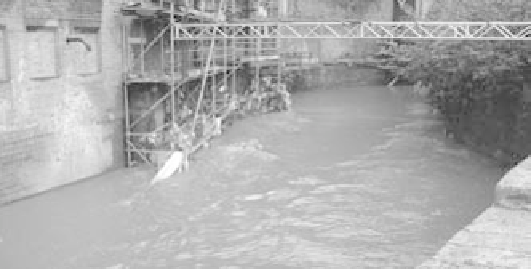Geoscience Reference
In-Depth Information
Low flow
Q
= 4 m
3
s
−
1
SSC = 14 mg L
−
1
SSL = 201 kg h
−
1
1
CuL = 0.1 kg h
−
1
PbL = 0.06 kg h
−
1
ZnL = 0.24 kg h
−
1
0.5
0
High flow
Q
= 19 m
3
s
−
1
SSC = 185 mg L
−
1
SSL = 12,664 kg h
−
1
1
CuL = 1.27 kg h
−
1
PbL = 0.76 kg h
−
1
ZnL = 3.16 kg h
−
1
0.5
0
Fig. 6.9
An urban river in low flow and high flow, showing typical stage and suspended sediment relationships (River Medlock,
Greater Manchester):
Q
, discharge; SSC, suspended sediment concentration; SSL, suspended sediment load; CuL, copper load; PbL,
lead load; ZnL, zinc load. (Photographs courtesy of J. Coyle.)
6.3.4 Urban canals, docks and lakes
are highly depositional in nature, resulting in
the rapid accumulation of sediment. This leads
to the requirement for regular dredging to pre-
serve navigable status (see section 6.6.2).
Sediments deposited within urban canals and
docks are predominantly derived from anthro-
pogenic sources (section 6.2.1.2), and these
anthropogenic sediments have mineralogical and
geochemical compositions significantly contrast-
ing to those of natural sediments. To date, how-
ever, very little research has been directed towards
detailing the mineralogy and geochemistry of
these sediments. Two aspects of urban canal and
dock sediments are apparent: they commonly
have a high organic matter loading as a result of
historical sewage input (Boyd et al. 1999; Taylor
et al. 2003), and have high metal loadings as a
consequence of industrial waste and discharges
(Bromhead & Beckwith 1994; Kelderman et al.
2000; Dodd et al. 2003). This high organic
and contaminant loading may lead to signific-
ant impacts upon overlying water quality as a
The major sites for sediment accumulation in
urban environments are canals, docks and lakes,
and these are often the terminal receiving water
bodies in urban catchments. Canals and docks
contrast with lakes in being artificial and heavily
engineered so possess unique hydrological and
sedimentological properties. Transport, especially
for industry, was a major component in urban
areas and as such navigable waterways and docks
were built to accommodate this. These are most
commonly freshwater in nature, but docks in
coastal urban environments may be marine, and
in the case of Venice, Italy, canals may also be
marine in nature. For the majority of urban canals
and docks, water and sediment are input via sur-
face water flow or direct industrial or domestic
discharge, and only occasionally are they fed
directly by rivers and groundwater. Owing to the
low-flow conditions in canals and docks, and the
steep-sided nature of these water bodies, they














